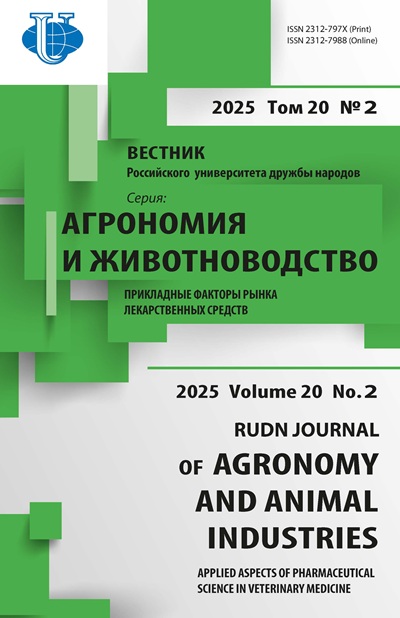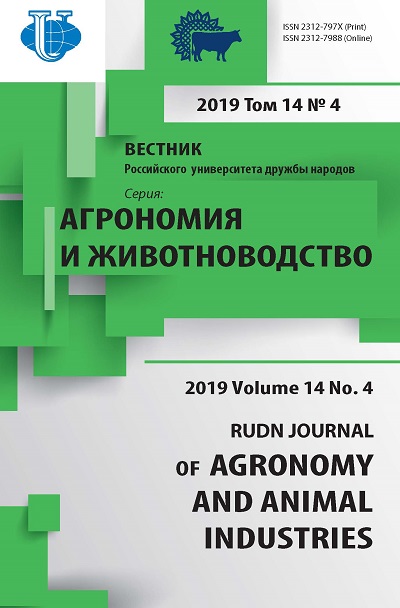Litter feed additive as source of amino acids and beneficial bacteria
- Authors: Stepanova A.M1, Tarabukina N.P1, Scryabina M.P1, Neustroev M.P1, Parnikova S.I1
-
Affiliations:
- Yakut Scientific Research Institute of Agriculture
- Issue: Vol 14, No 4 (2019)
- Pages: 466-480
- Section: Animal breeding
- URL: https://agrojournal.rudn.ru/agronomy/article/view/19531
- DOI: https://doi.org/10.22363/2312-797X-2019-14-4-466-480
- ID: 19531
Cite item
Full Text
Abstract
Feed additive was derived from poultry manure by microbiological synthesis. After a 10-day feeding poultry with probiotic strains of bacteria B. subtilis TNP-3 and B. subtilis TNP-5, the litter does not contain potential enteropathogens and can be used as a raw material for feed additive. Based on the results of microbiological and biochemical studies the technology of feed additive (powder) with the use of extrusion was developed. Extrusion at a temperature of up to 120 °C for 5-6 seconds provides presence of beneficial bacteria and significantly high content of essential amino acids. According to the results of biochemical studies, litter feed additive contains 18 free amino acids. The total concentration of free amino acids in the feed additive (powder) is 406.3 mg/kg, which is 1.7 times higher than that in the litter without fermentation and extrusion. The experiments have shown that inclusion of 3.3% feed additive in the diet does not have negative effect on physiological state, viability and productivity of laying hens. Survival of birds in both groups was 100%. Additive application in the experimental group of chickens revealed absence of opportunistic pathogenic microorganisms and microscopic fungi, presence of bifidobacteria and spore-forming aerobic Bacillus bacteria in powder, as well as predominance of beneficial micro flora and lack of potential enteropathogens (compared to control). It allows to conclude that feed additive obtained by microbiological synthesis from bird droppings possess probiotic properties. The results of biochemical study of egg production indicate that the use of food additives (to 3.3% of the basic diet) for laying hens significantly increases content of major micro and macro-elements in eggs, compared to the control. Therefore, the use of feed additive-powder (up to 3.3% of the basic diet) does not reduce egg quality. Thus, based on the results of these studies, it can be concluded that the litter obtained from laying hens, after application of probiotic ‘Nord-Bakt’, further fermentation with strains Bacillus subtilis TNP-3 and Bacillus subtilis TNP-5, followed by extrusion can be used as a feed additive as a source of amino acids and beneficial bacteria.
About the authors
Anna M Stepanova
Yakut Scientific Research Institute of Agriculture
Author for correspondence.
Email: stepanova_anna1985@mail.ru
Candidate of Veterinary Sciences, senior researcher, Laboratory for development of microbial preparations
Yakutsk, Russian FederationNadezhda P Tarabukina
Yakut Scientific Research Institute of Agriculture
Email: hotubact@mail.ru
Doctor of Veterinary Sciences, Professor, Head of Laboratory for development of microbial preparations
Yakutsk, Russian FederationMarfa P Scryabina
Yakut Scientific Research Institute of Agriculture
Email: hotubact@mail.ru
Candidate of Veterinary Sciences, leading research associate, Laboratory for development of microbial preparations
Yakutsk, Russian FederationMikhail P Neustroev
Yakut Scientific Research Institute of Agriculture
Email: mneyc@mail.ru
Doctor of Veterinary Sciences, Professor, Head of Laboratory of veterinary biotechnology
Yakutsk, Russian FederationSvetlana I Parnikova
Yakut Scientific Research Institute of Agriculture
Email: hotubact@mail.ru
candidate of veterinary sciences, senior researcher, Laboratory for development of microbial preparations
Yakutsk, Russian FederationReferences
- Kisil I, Ter-Sarkisyan E. The poultry's dung is a source of growth promoters. Kombikorma. 2007; (8):83-84. (In Russ).
- Bolotina EN. Extruded feeds use for pigs fattening. Bulletin Samara state agricultural academy. 2014; (1):118-122. (In Russ).
- Garzanov A, Dorofeeva O, Kapustin C. Extruded feed from biowaste. Kombikorma. 2011; (8):47-48. (In Russ).
- Artemieva SA, Artemieva TN, Dmitrieva AI, Dorutina VV. Mikrobiologicheskii kontrol' myasa zhivotnykh, ptitsy, yaits i produktov ikh pererabotki: spravochnik [Microbiological control of animal meat, poultry, eggs and their products: handbook. Moscow: KolosS Publ.; 2002. (In Russ).
- Sidorov MA, Skorodumov DI, Fedotov VB. Opredelitel' zoopatogennykh mikroorganizmov: spravochnik [Determinant of zoopathogenic microorganisms: a guide]. Moscow: Kolos Publ.; 1995. (In Russ).
- Berkeley R, Bock E, Boone D, Brenner D. Opredelitel' bakterii Berdzhi: Spravochnik: v 2 t. [The determinant of bacteria Bergey: a guide: in 2 volumes]. Vol. 1. 9th ed. Moscow: Mir Publ.; 1997. (In Russ).
- Cherepneva IE. Sovremennye metody issledovaniya mikroorganizmov [Modern methods for study of microorganisms]. Kazan: KSU Publ.; 1998. (In Russ).
- Stepanova AM. Tekhnologiya primeneniya probiotika iz shtammov bakterii B. subtilis TNP-3 i B. subtilis TNP-5 v ptitsevodstve [The technology of using a probiotic from B. subtilis TNP-3 and B. subtilis TNP-5 bacterial strains in poultry farming] [Dissertation] Yakutsk; 2011. (In Russ).
- Gryazneva TN. Tekhnologiya proizvodstva probiotika Biod-5 i ego lechebno-profilakticheskaya effektivnost' dlya raznykh vidov zhivotnykh [The production technology of probiotic Biod-5 and its therapeutic and prophylactic efficacy for different types of animals] [Dissertation]. Moscow; 2005. (In Russ).
- Tatarchuk OP. General properties of Bacillus subtilis CBS 117162 probiotic strain and feed additive thereof. Veterinary medicine. 2012; (4):20-22. (In Russ).
- Dhama K, Verma V, Sawant PM, Tiwari R, Vaid RK, Chauhan RS. Applications of probiotics in poultry: enhancing immunity and beneficial effects on production performances and health. Journal of Immunology and Immunopathology. 2011; 13(1):1-19.
- Park YH, Hamidon F, Rajangan C, Soh KP, Gan CY, Lim TS, Abdullah WN, Liong MT. Application of probiotics for the production of safe and high-quality poultry meat. Korean J Food Sci Anim Resour. 2016; 36(5): 567-576. doi: 10.5851/kosfa.2016.36.5.567
- Malik EV, Kozak SS, Adamov AN. The use of probiotic additive ‘Biocorm Pioneer’ to increase microbiological safety of poultry products. In: Novye mirovye tendentsii v proizvodstve produktov iz myasa ptitsy i yaits [New global trends in the production of products from poultry meat and eggs]. Moscow: VNIIPP Publ.; 2006. p. 205-209. (In Russ).
- Panin AN, Malik IN. Probiotics in rational feeding of animals. Probiotics, prebiotics, synbiotics and functional foods. Klinicheskoe pitanie. 2007; (1-2):59-60.
- Samburov NV, Trubnikov DV, Popov VS, Babaskin RN. Probiotic feed additives in technology of cultivation weaned piglets. Vestnik of Kursk State Agricultural Academy. 2017; (2):29-34. (In Russ).
- Stepanova AM, Tarabukina NP, Neustroev MP, Neustroev DD, Parnikova SI, Fedorova MP. Feed additive obtained by micro-biological synthesis from poultry waste. Trudy VIEV. 2016; 79:289-296. (In Russ).
- Fisinin VI, Egorov IA, Okolelova TM, Imangulov SA. Nauchnye osnovy kormleniya sel'skokhozyaistvennoi ptitsy [Scientific principles of feeding poultry]. Sergiev Posad: VNITIP Publ.; 2009. (In Russ).
- Nozdrin GA, Ivanova AB, Shevchenko AI, Shevchenko SA. Probiotiki i mikronutrienty pri intensivnom vyrashchivanii tsyplyat krossa Smena [Probiotics and micronutrients during intensive rearing of Smena chickens]. Novosibirsk: Ornament Publ.; 2009.
Supplementary files















